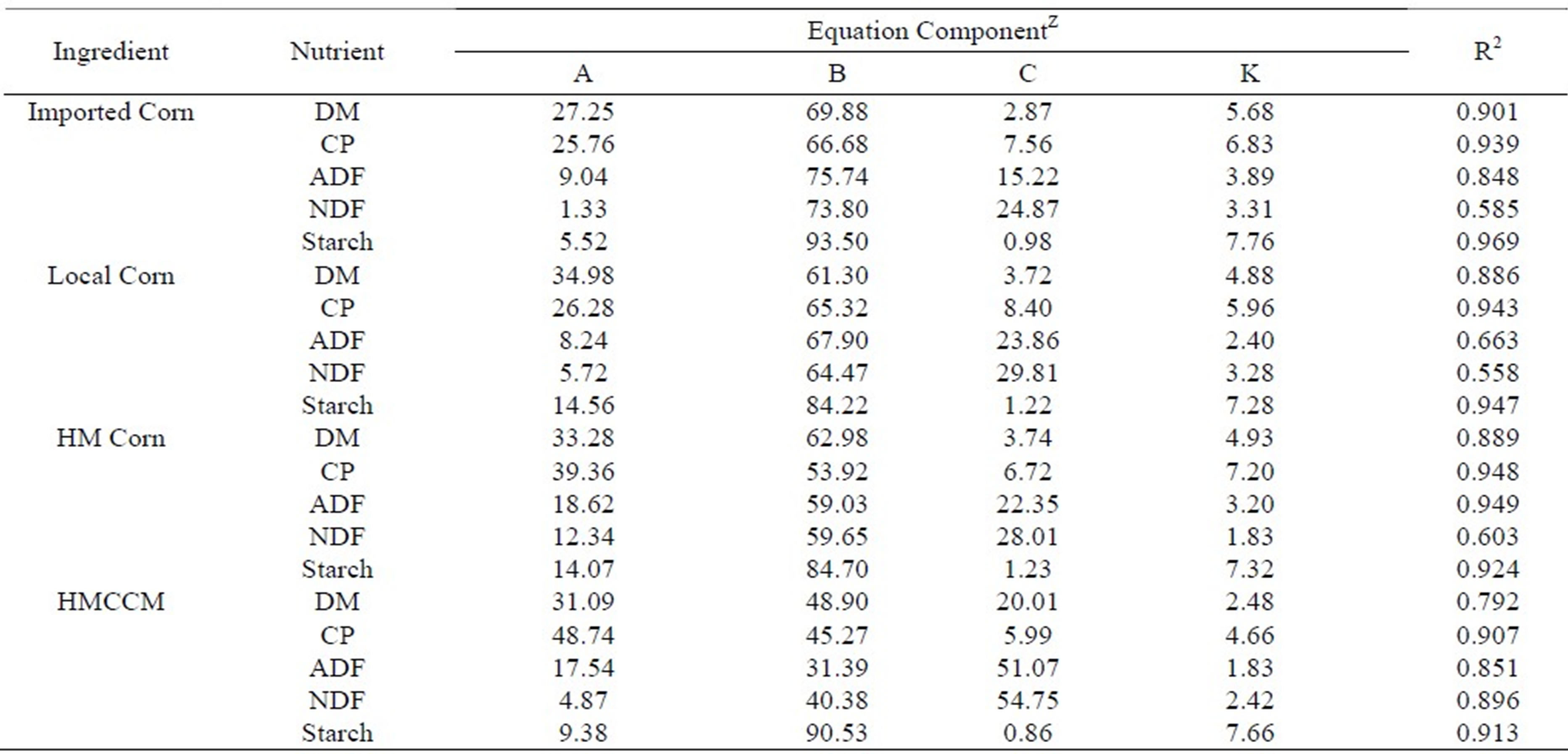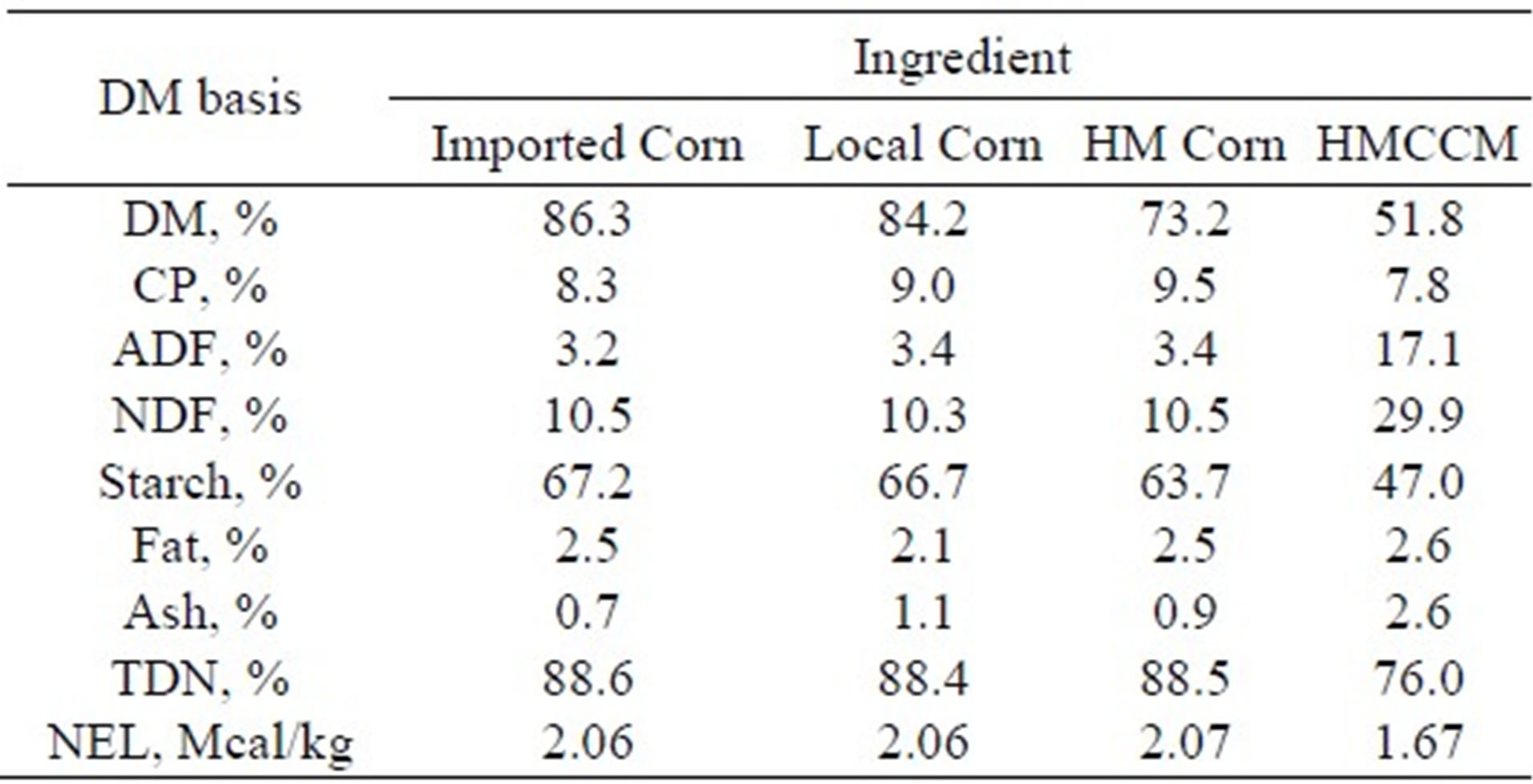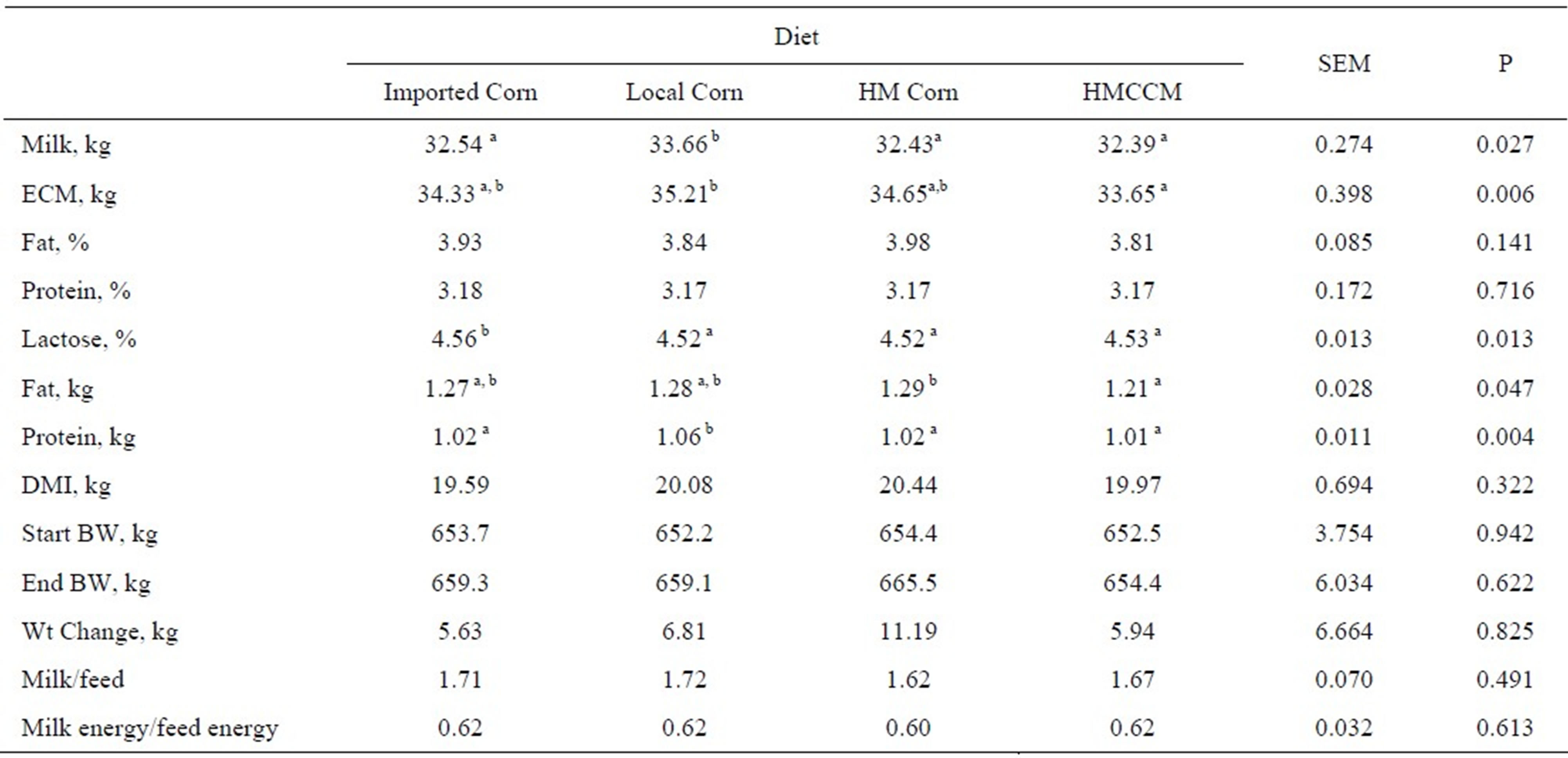Open Journal of Animal Sciences
Vol.3 No.1(2013), Article ID:27430,6 pages DOI:10.4236/ojas.2013.31010
Evaluation of grain corn grown in New Brunswick for dairy cows
![]()
1Essi Evans Technical Advisory Services, Inc., Bowmanville, ON, Canada; *Corresponding Author: essievans@sympatico.ca
2Atlantic Dairy and Forage Institute, Fredericton Junction, NB, Canada
3New Brunswick Department of Agriculture & Aquaculture, Fredericton, NB, Canada
Received 1 November 2012; revised 1 December 2012; accepted 22 December 2012
Keywords: Corn; In Sacco Digestibility; Digestion Rates; Diet Digestibility
ABSTRACT
Corn harvested as grain is a relatively new crop for the province of New Brunswick. The recent availability of local corn has the potential to improve the sustainability of the dairy industry in New Brunswick, but there is debate within the industry concerning the value and best use of the grain. This experiment was conducted to assess the feeding value of locally-produced corn grain stored as dry grain, ensiled high moisture corn, or ensiled as high moisture corncob meal (HMCCM, unhusked ears sometimes referred to as snaplage) relative to dry grain obtained from Ontario. Three samples of each were evaluated In Sacco. Rates and extent of digestion were similar for local and Ontario corn regardless of presentation for crude protein and starch, but acid detergent fiber, neutral detergent fiber and dry matter digestibility values were lower for HMCCM than other treatments. A 4 × 4 Latin square study was conducted with 16 Holstein cows and 28 day feeding periods. Milk production and milk protein production were higher (P < 0.05) with the locally produced dry corn than with other treatments. Energy corrected milk was lowest with the HMCCM diet. These results indicated that the value of corn produced in New Brunswick is similar to that produced in Ontario.
1. INTRODUCTION
Corn is the primary grain used in animal feed in North America, supplying a greater energy density than smaller grains. New earlier maturing corn hybrids are now being grown in New Brunswick (NB) and other Maritime provinces of Canada, reducing the need to import corn from the United States and more temperate Central Canada, thereby improving the sustainability of the local dairy industry.
Once harvested, corn may be stored as dry corn, or ensiled as (high moisture) HM shelled corn, HM ear corn or high moisture corncob meal (HMCCM, unhusked ears also called snaplage). Greater amounts of feed are harvested and available for feeding with high moisture ear corn than with HM shelled corn, and with HMCCM relative to HM ear corn. However, each successive increase in feed volume results in a dilution of the grain with fiber, and it is not known which form offers the greatest economic opportunities for dairy producers under Maritime Canada conditions.
For as much corn as is fed to dairy cows in North America, there is surprisingly little comparative information on its comparative feeding value. Wilkerson et al. [1] determined that cows receiving HM corn (76% DM) produced more milk than those receiving dry corn. The energy stored in HM corn as lactic and volatile fatty acids produce a denser source of energy than the sugars and starches in dry corn, resulting in more energy per unit of dry weight [2].
HM corn has been shown to have a more rapid rate of digestion than dry corn, resulting in a greater portion digested in the rumen. Cooper et al. [3] determined that steers digested approximately 20% more starch within the rumen with HM than with dry rolled corn, which resulted in almost 30% more microbial protein available. This reduces the quantities of starch and nitrogen entering the lower gut with HM corn, relative to dry, and resulted in lower emissions of odorous compounds in manure in one study [4].
HMCCM is often a means of salvaging a significant part of a corn crop when it cannot be harvested as silage [5]. Harrison and Johnson [6] acknowledged that HMCCM may be more likely to contain molds and mycotoxins than grain storage forms that do not contain husks. Mycotoxin levels are likely a concern when the crop has been damaged by environmental conditions like hail or drought.
A survey of dairy producers and corn growers in New Brunswick found that most have or can readily access equipment to harvest HM shelled corn and HMCCM, without large capital investments in harvesting equipment (personal communication with Milk 2020). The survey also found that dairy producers and feed suppliers suspected that locally grown hybrids of corn differed nutritionally from corn produced in traditional geographic areas. This study was conducted to determine the nutritive value and assess lactational performance of cows provided with imported dry corn, local dry corn, HM shelled corn and HMCCM.
2. MATERIALS AND METHODS
2.1. In Sacco Digestion Study
Locally produced samples of dry shelled corn, HM shelled corn, and HMCCM were evaluated, and compared to imported dry shelled corn (Southwest Ontario, Canada). Three samples of each product were obtained for the study. All samples were submitted to New Brunswick Agriculture Laboratory in Fredericton for wet chemistry analyses. Four replicate sub-samples of each product were incubated in the rumens of two, lactating Holstein cows for 6, 12, 18, 24 and 48 hours, using the procedure developed by McQueen et al. [7]. Briefly, 5 gram samples were incubated in 9 × 17 cm bags constructed from Nitex bolting cloth (53 um pore size), removed and washed in cold water for 30 minutes. Samples were dried in a forced-air drying oven at 55 C for 48 hours, and ground to pass through a 1 mm screen.
Residue weights were used to determine dry matter (DM) disappearance. After DM disappearance was determined, residues were pooled by cow and time and analyzed for crude protein (CP), acid detergent fiber (ADF), neutral detergent fiber (NDF) and starch. Rates of disappearance of each nutrient were determined using the model described by Orskov and McDonald [8]:

where, A = the soluble fraction, B = the slowly degraded fraction and k = the fractional rate of disappearance of fraction B, e = the exponential function and t = time in hours. Extent of digestion (potential digestibility) for each nutrient pool was computed as the residue remaining after 48 hours, and C = 100-extent of digestion.
2.2. Feeding Study
Sixteen high producing Holstein cows were used in a replicated 4 × 4 Latin Square experiment, with periods of 28 days. Cows were blocked by age and production. Diets were formulated using the CPM platform of the Cornell Net Carbohydrate-Protein System (CPM Dairy Version 3.01, Cornell, Penn Miner, University of Pennsylvania, Philadelphia, PA, USA) to contain similar levels of net energy and nutrients using the differing grain forms. All corn products were ground to pass through a 4 mm screen prior to feeding, while the HMCCM was processed through a kernel processor at harvest. Diets were mixed and issued twice daily in sufficient quantities to permit approximately 10% orts. Forage DM was determined twice/week and were used to adjust rations as necessary. Each total mixed ration (TMR) was sampled weekly, with the samples stored frozen for analysis. Treatments were: Imported corn-dry shelled corn purchased from a grain elevator in Ontario (ON), Local corn-dry shelled corn produced in NB, Local HM-HM shelled corn grown in NB and HMCCM-snaplage produced in NB.
Cows were weighed at the beginning of each period and at the end of the trial in order to determine change in body weight. Milk weights, feed issued, orts and feed consumed were determined daily. On the last two days of each period, samples of milk were obtained from AM and PM milking. Milk samples were submitted to the Valacta analysis laboratory in Prince Edward Island, Canada for component analysis. Energy corrected milk (ECM) was calculated according to Shirley [9] for milk standardized at 3.5% fat and 3.2% crude protein. Milk energy was calculated as 0.62 Mcal/kg of ECM.
2.3. Statistical Analyses
In Sacco digestibility data were analyzed using the ANOVA procedure of Minitab 16 (Minitab Inc., State College, PA, USA) with samples as random variables.
Animal performance parameters were analyzed using the GLM procedure of Minitab. The model included the main effects of animal, period, blocks and treatment. In the model, animals and periods were random and treatment and blocks was computed as fixed effects.
3. RESULTS AND DISCUSSION
Table 1 provides the chemical compositions of the ingredients evaluated in the In Sacco study. Differences between the imported and local corn samples appeared to be minor. The concentration of starch was somewhat lower in the HM than dry corn, likely due to fermentation changes. ADF and NDF levels were higher in the HMCCM owing to the presence of the fibrous husk and cob. Rates of digestion and pool sizes were generated for the ingredients (Table 2) in order to provide better predictions of nutritive values to be used in models. Starch digestion rates appeared to be similar for all sources. Cooper et al. [3] found that HM corn had a higher rate of starch digestion than dry corn. In the current study, the corn grain was ground to pass through a 4 mm screen. In the experiment described by Cooper et al. [3], the corn samples were rolled, resulting in larger particles with less exposure to rumen microbes.
Table 3 provides In Sacco digestibility of nutrients as determined from the 48 h incubation of samples. Digestibility of DM, CP, ADF and NDF was lower for HMCCM than for the grain ingredients. Starch digestibility values did not differ with source. These values are higher than actual digestibility for fibrous components, due to passage of material out of the rumen before 48 h.
While there were some differences in pool sizes, rates of digestion and digestibility values for nutrients as determined by region, differences much greater than these have been found for corn planted in the same region and crop year [10,11]. Common corn varieties are composed of varying combinations of two types of starch: starch that is made up of highly branched amylopectin is floury and readily holds water while starch that is made up of straight chains of glucose is flinty and does not hydrate well [10]. Most varieties of corn contain a combination of the two types of molecules, and rumen digestibility changes with the proportions. As well, vitreousness is associated with reduced starch access [12] due to hindrance caused by prolamins. Taylor and Allen [13] increased rumen starch digestibility of corn grain in lactating dairy cows from 35% to 57% when corn grain with a floury endosperm was fed in exchange for vitreous corn grain.
Table 1. Chemical compositions of ingredients evaluated in the In Sacco study (means ± SD for 3 samples).

Table 2. Pool sizes and rates of digestion for insoluble available nutrient pools for corn samples (N = 3).

ZA = soluble pool, B = insoluble pool, C = unavailable pool, K = rate of digestion (%/h) of the insoluble pool.
Table 3. In Sacco 48 hour digestibility values for corn samplesZ.

ZN = 24 for dry matter and 3 for the remaining nutrients due to pooling of residues for analysis.
Physical form is likewise an important determinant of the rate and extent of digestion of corn in the rumen. Nocek [14] found that differences in rumen DM digestion of shelled corn, ear corn, HM corn and HM ear corn could be narrowed through grinding.
Nutrient values for the materials used in the feeding study are given on Table 4. Values were quite similar for the Imported, Local and Local HM grains. The ingredients obtained for the feeding study were representative of the samples analyzed in the In Sacco experiment.
All diets were formulated to meet requirements for 35 liters of milk containing 3.6% butterfat and 3.30% total protein. The imported corn was replaced by local shelled corn and local high moisture shelled corn for treatments 2 and 3, respectively. For treatment 4, the HMCCM replaced the imported corn and a part of the corn silage in the diet. The intended nutrient profiles were similar for all treatments (Table 5). The actual nutrient profiles of the diets were similar across treatments, but somewhat lower in protein than formulated (Table 6).
Results from the feeding experiment are provided in Table 7. Milk production was highest (P < 0.05) with the locally produced dry corn. When expressed on an ECM basis, production from local corn diet was found to be greater than for the HMCCM diet (P < 0.05). There were no differences (P > 0.05) in milk fat and milk protein percentages. However, milk fat yields were greatest with the high moisture corn diet, and lowest with the HMCCM diet. Protein yields were higher (P < 0.05) when the cows received the diet containing the locally produced dry corn than when the cows were given any of the other diets. There were no differences (P > 0.05) in DMI that could be associated with the feeding regimens.
Table 4. Chemical compositions of the ingredients used in the feeding trial.

Table 5. Ingredient and calculated nutrient compositions of the diets used in the feeding study.

Table 6. Actual analyses of diets used in the feeding study (mean of 16 weekly samples).

Table 7. Performance results from the corn feeding study.

Processing can contribute to overcoming suspected differences in accessibility to starch in the rumen and to the overall availability of energy from the grain. Ekinci and Broderick [15] determined that grinding HM ear corn prior to feeding increased milk yield by 4 kg/day, and permitted better use of rumen available nitrogen. Zinn et al. [16] showed that flaking of corn grain increased rumen digestion, resulting in 18% higher net energy, with most of the gain in energy due to greater rumen starch accessibility. It seems likely that processing provides advantages needed to overcome any innate differences in corn due to geographic region of production The grains used in this study were finely ground, and the HMCCM was kernel processed, resulting in very similar particle sizes as well as access to the starch in the rumen. All attempts were made to fairly compare the grains used in this study. It would therefore appear that the feeding value of the dry corn harvested in NB was comparable to that from ON. HM and HMCCM provide viable options for storing locally produced corn.
4. ACKNOWLEDGEMENTS
The authors are indebted to Growing Forward and Milk 2020 for funding this research.
REFERENCES
- Wilkerson, V.A., Glenn, B.P. and McLeod, K R. (1997) Energy and nitrogen balance in lactating cows fed diets containing dry or high moisture corn in either rolled or ground form. Journal of Dairy Science, 80, 2487-2496. doi:10.3168/jds.S0022-0302(97)76201-5
- Klosterman, E.W., Johnson, R.R., Scott, H.W., Moxon, A.L. and Van Stavern, J. (1960) Whole plant and ground ear corn silages, their acid content, feeding value and digestibility. Journal of Animal Science, 19, 522-532.
- Cooper, R.J., Milton, C.T., Klopfenstein, T.J., Scott, T.L., Wilson, C.B. and Mass, R.A. (2002) Effect of corn processing on starch digestion and bacterial crude protein flow in finishing cattle. Journal of Animal Science, 80, 797- 804.
- Archibeque, S.L., Miller, D.N., Freetly, H.C. and Ferrell, C.L. (2006) Feeding high moisture corn instead of dryrolled corn reduces odorous compounds production in manure of finishing beef cattle without decreasing performance. Journal of Animal Science, 84, 1767-1777. doi:10.2527/jas.2005-448
- Lardy, G. (2004) Earlage offers corn producers an option. North Dakota Extension Service. http://www.ext.nodak.edu/extnews/newsrelease/2004/111104/07earlag.htm
- Harrison, J. and Johnson, L. (2002) Managing silage for profit and environmental stewardship. Proceedings of the Pacific Northwest Animal Nutrition Conference, 115.
- McQueen, R.E., Buch, R.S. and Nicholson, J.W.G. (1980) Variability of forage digestion in nylon bags suspended in the rumen. Canadian Journal of Animal Science, 60, 1038.
- Orskov. E.R., and McDonald, P. (1979) The estimation of protein degradability in the rumen from incubation measurements weighted according to rate of passage. Journal of Agricultural Science (Cambridge), 92, 499-503. doi:10.1017/S0021859600063048
- Shirley, J.E. (2006) Milk efficiency is an important management tool for dairy producers. Proceedings of the High Plains Nutrition Conference, 63-67.
- Firkins, J.L., Eastridge, M.L., St. Pierre, N.R. and Noftsger, S.M. (2001) Effects of grain variability and processing on starch utilization in lactating dairy cows. Journal of Animal Science, 79, E218-E238.
- Esker, P., Shaver, R., Leverich, J., Ballweg, M., Hoffman, P. and Rankin, M. (2010) 2009-2010 dairy cattle feeding issues with high moisture corn, snaplage and dry shell corn. http://www.uwex.edu/ces/dairynutrition/documents/09-10cornfordairycattleeskeretal.v10-28-2009.pdf
- Lopes, J.C., Shaver, R.D., Hoffman, P.C., Akins, M.S., Bertics, S.J., Gencoglu, H. and Coors, J.C. (2009) Type of corn endosperm influences nutrient digestibility in lactating dairy cows. Journal of Dairy Science, 92, 4541-4548. doi:10.3168/jds.2009-2090
- Taylor, C.C. and Allen, M.S. (2005) Corn grain endosperm type and brown midrib 3 corn silage: Site of digestion and ruminal digestion kinetics in lactating cows. Journal of Dairy Science, 88, 1413-1424. doi:10.3168/jds.S0022-0302(05)72809-5
- Nosek, J.E. (1987) Characterization of in situ dry matter and nitrogen digestion of various corn grain forms. Journal of Dairy Science, 70, 2291-2301. doi:10.3168/jds.S0022-0302(87)80289-8
- Ekinci, C. and Broderick, G.A. (1997) Effect of processing high moisture ear corn on ruminal fermentation and milk yield. Journal of Dairy Science, 80, 3298-3307. doi:10.3168/jds.S0022-0302(97)76305-7
- Zinn, R.A., Owens, F.A. and Ware, R.A. (2002) Flaking corn: Processing mechanics, quality standards and impact on energy availability and performance of feedlot cattle. Journal of Animal Science, 80, 1145-1156.

